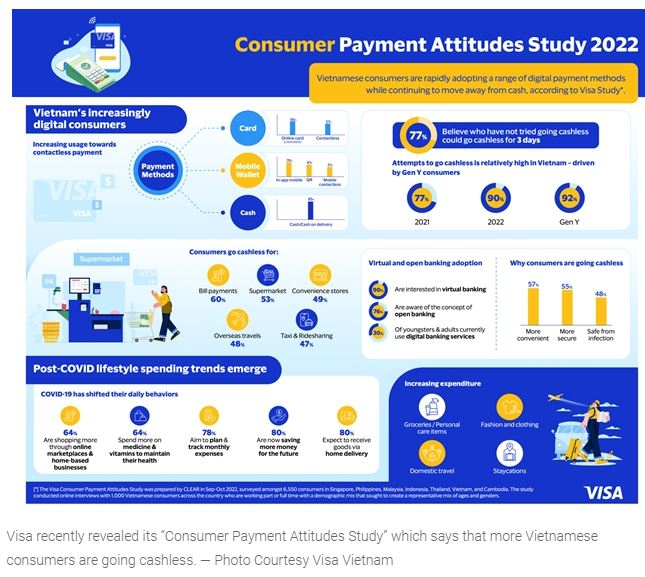More Vietnamese consumers go cashless: study
Some 77 per cent of Vietnamese consumers believe they could go cashless for three days, according to a new survey by Visa entitled “Consumer Payment Attitudes Study 2022”.
HCM CITY — Some 77 per cent of Vietnamese consumers believe they could go cashless for three days, according to a new survey by Visa entitled “Consumer Payment Attitudes Study 2022”.
In the study, Visa found that 90 per cent of study respondents attempted to go cashless at some point in 2022, as compared to 77 per cent in 2021.
The COVID-19 pandemic transformed consumer behaviour worldwide, and Việt Nam was no exception, Visa said, adding that the percentage of Vietnamese consumers using card or mobile wallet payments increased across every category compared to 2021.
According to the study, 66 per cent of consumers used online card payments last year, while 70 per cent used online or in-app mobile wallet payments, a dramatic increase from 32 per cent in 2021.
“Digital payments continue to grow in popularity among consumers in Việt Nam, with VisaNet data showing that the payment volume across all Visa payment methods in the country rose 32 per cent year-on-year in 2022, payment value through online transactions also rose substantially, while cross-border payment volume growth more than doubled compared to the previous year,” Dung Đặng, Visa country manager for Việt Nam and Laos, said.
QR payments also experienced substantial growth in usage last year, with 61 per cent of consumers using this method, as compared to 35 per cent in 2021.
Taken together, this indicates a gradual shift away from cash, evidenced by the fact that consumers both carried less cash in 2022 and used it for fewer payments, according to the study.
The two most common reasons for fewer cash payments include the possibility of losing it or having it stolen, and the fact that more businesses now support cashless payment methods.
Increased use of digital options is evident beyond payment methods as well with 90 per cent of Vietnamese consumers being interested in virtual banking.
Post-COVID consumer behaviour is also coming into focus. New trends have emerged in what consumers spend their money on in the retail space, and how they approach their finances overall, the study found.
It shows that Vietnamese have embraced home delivery, with tech-enabled online payment pre-delivery being the most popular method. Overall, 85 per cent of consumers tried home delivery for the first time during the pandemic, and in the future, they expect 8 out of 10 purchases to be made online and be received via home delivery. Offering online payment and home delivery are clear needs for businesses moving forward.
New shopping habits have also emerged, with 64 per cent of consumers purchasing more medicine and vitamins to maintain their health, while the same percentages are shopping through large online market places and home-based businesses. These spending habits reflect global post-COVID trends, in which e-commerce has grown rapidly while a majority of consumers are trying new shopping behaviours.
Shifting saving and spending trends, meanwhile, mean businesses must adapt to different behaviour. Some 80 per cent of consumers say they are now saving more money for the future, while 78 per cent aim to closely plan and track monthly expenses. This indicates a widespread focus on being financially responsible, as does the nearly universal setting of monthly budgets for household expenditures.
As a result, consumers are likely to reduce spending on certain items, which businesses must anticipate. On the other hand, businesses can move into areas where consumers plan to increase spending, including groceries, fashion and clothing, and staycations or domestic travel, according to Visa. — VNS


 Thailand
Thailand




